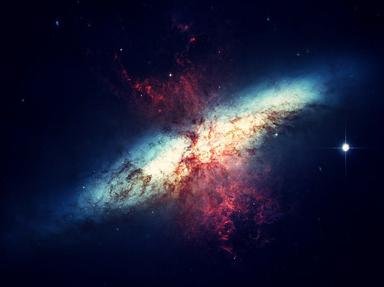Quiz Answer Key and Fun Facts
1. The Goldilocks Planet: Welcome to one of the most famous exoplanets, Gliese 581 c, which has been known to exist in the "Goldilocks zone". This is the habitable zone in which a planet orbits its star where it is not too hot or not too cold. But this planet is tidal locked, meaning it doesn't rotate like Earth. The part of the planet always facing its star is blazing hot and the part always facing away is freezing cold. This means that the small probability of liquid water and life exists in what area on the planet?
2. The Glass Rain Planet: Here we have the planet HD 189733b, which is a beautiful deep azure color. Unfortunately, you don't want to step foot on the planet as you will be pelted with harsh sideways winds blowing shards of glass. What compound do scientists believe composes this glass rain?
3. The Dark Planet: The exoplanet TrES-2b is the darkest planet discovered so far, darker than coal. Mercury, the darkest planet in our solar system, reflects 10% of light. How much light does TrES-2b reflect?
4. The Old Planet: Planet PSR B1620-26b is the oldest planet discovered in the Milky Way galaxy at 13 billion years old. It even orbits a pair of burned-out stars. What very old biblical figure is the planet nicknamed after?
5. The Waterworld: GJ 1214b is an exoplanet believed to be covered with water, perhaps including in its atmosphere. But before you start imagining a scene from "Interstellar", life on this planet is not possible. Counterintuitively, why is that?
6. The Diamond Planet: Exoplanet 55 Cancri e is interesting in that scientists published a study in 2010 stating that it could be filled with an incredible amount of solid diamond inside its crust. Newer discoveries call that into question, but nonetheless, the planet is believed to have a large ratio of what element compared to oxygen?
7. The Hot Ice Planet: This planet, Gliese 436 b, is so close to its star that it takes less than three days to make one full orbit. But the strange part is that this planet also contains quite a large amount of ice. How do scientists believe this is possible?
8. The Triple Sunset Planet: HD 188753 Ab is a possible exoplanet which is in an unusual position: similar to the double sunset made famous in "Star Wars", this planet has three stars in its vicinity. If the exoplanet is confirmed, in what strange situation are these three stars in relation to HD 188753 Ab?
9. The Meteor Shower Planet: The exoplanet HD 69830 c would have quite a night sky show. Why would you see so many celestial events on this planet?
10. The Eaten Alive Planet: If you were to visit WASP-12b, you would not want to get too close as the star it orbits is absorbing the planet little by little. The doomed planet is believed to only last for another 10 million years before it is completely consumed (a relatively short time in universal existence). The planet is distorted by heat and pressure and is what shape?
Source: Author
trident
This quiz was reviewed by FunTrivia editor
rossian before going online.
Any errors found in FunTrivia content are routinely corrected through our feedback system.

